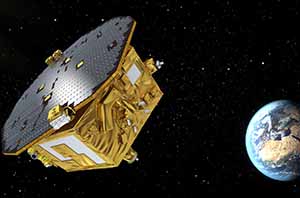New result shows that sensitive systems for detecting gravitational waves can work in orbit
June 7, 2016
A key component of a future gravitational wave observatory passed a series of tests with flying colors. The Laser Interferometer Space Antenna (LISA) Pathfinder mission is a European Space Agency (ESA) project that proves in principle that an orbiting formation of spacecraft will be able to function as a space-based gravitational wave observatory. A paper detailing the first results from the LISA Pathfinder mission appears in Physical Review Letters along with an accompanying Viewpoint commentary in Physics.
At the heart of the experiment is a two-kilogram cube of a high-purity gold and platinum alloy, called a test mass. The cube is nestled inside the shell-like LISA Pathfinder spacecraft, and has been in orbit since February 2016. The researchers found the test mass could be sufficiently stable and isolated from outside forces to fly in space and detect a whole new range of violent events that create gravitational waves.
The LISA Pathfinder spacecraft is equipped with electrodes adjacent to each side of the test mass cube to detect the relative position and orientation of the test mass with respect to the spacecraft. An array of tiny thrusters on the outside of the spacecraft compensates for forces that could affect the test mass orbit, chiefly including the pressure from the solar photon flux.
The mission is a crucial test of systems that will be incorporated in three spacecraft that will comprise the Laser Interferometer Space Antenna (LISA) gravitational wave observatory scheduled to launch in 2034. The LISA observatory will follow a heliocentric orbit trailing fifty million kilometers behind the Earth. Each LISA spacecraft will contain two test masses like the one currently in the LISA Pathfinder spacecraft. The LISA Pathfinder mission’s success is a crucial step in developing the LISA observatory.
In the LISA observatory mission planned for 2034, laser interferometers will measure the distances between test masses housed in spacecraft flying in a triangular configuration roughly a million kilometers on a side. The LISA Pathfinder spacecraft contains a second test mass to form a minuscule equivalent of one leg of the triangular LISA formation. The second Pathfinder mass is electrostatically manipulated to maintain its position relative to the free falling test mass. The masses are separated by only about a third of a meter, which is far too short for the detection of gravitational waves, but is vital for testing the systems that will eventually make up the LISA observatory.
Researchers report that the system reduces acceleration noise between the test masses to less than 0.54 x 10-15 g/(Hz)^½ over a frequency range of 0.7 mHz to 20 mHz. The noise in this range is five times lower than the LISA Pathfinder design threshold, and within a factor of 1.25 of the LISA observatory requirements. Above 60 mHz, acceleration noise is two orders of magnitude better than design requirements. According to the researchers, the measured performance of the Pathfinder mission systems would allow gravitational wave observations close to the original plan for the LISA Observatory.

Credit: ESA–C.Carreau
Related Information






